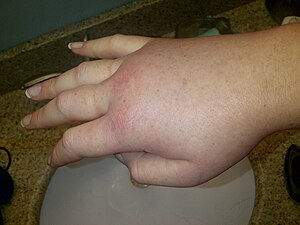Hereditary angioedema
| Hereditary angioedema | |
|---|---|
 |
|
| Swollen right hand during a hereditary angioedema attack. | |
| Classification and external resources | |
| Specialty | hematology |
| ICD-10 | D84.1 (ILDS D84.110) |
| ICD-9-CM | 277.6 |
| OMIM | 106100 |
| DiseasesDB | 1821 |
| MedlinePlus | 001456 |
| eMedicine | article/1048994 |
| Patient UK | Hereditary angioedema |
| MeSH | D054179 |
| Orphanet | 91378 |
Hereditary angioedema (HAE) is a rare, autosomal dominantly inherited blood disorder that causes episodic attacks of swelling that may affect the face, extremities, genitals, gastrointestinal tract and upper airways. In this form of angioedema, swellings of the intestinal mucous membrane may lead to vomiting and painful, colic-like intestinal spasms that may mimic intestinal obstruction. Airway edema may be life-threatening. Episodes may be triggered by trauma, surgery, dental work, menstruation, some medications, viral illness and stress; however, this is not always readily determined. This disorder affects approximately one in 10,000–50,000 people.
The underlying cause of most HAE is autosomal dominant inheritance of mutations in the C1 inhibitor gene (C1-INH gene or SERPING1 gene), which is mapped to chromosome 11 (11q12-q13.1).To date there are over 300 known genetic mutations that result in a deficiency of functional C1 inhibitor protein. The majority of HAE patients have a family history; however, 25% are the result of new mutations. The low level of C1 inhibitor in the plasma leads to increased activation of pathways that release bradykinin, the chemical responsible for the angioedema due to increased vascular permeability, and the pain seen in individuals with HAE.
The most common form of the disorder is HAE type I, which is the result of abnormally low amounts (low serum levels) of C1 inhibitors, which are responsible for maintaining proper balance (homeostasis) in the complement system (specifically, keeping the C1 part of the classical complement pathway from being overactive). This inhibition helps to regulate various body functions (e.g., flow of body fluids in and out of cells). HAE type II is a more uncommon form of the disorder. It occurs as the result of the production of C1 inhibitor that is normal in amount but does not work well (abnormal structure and function). Type II accounts for about 15–20% of HAE. Type III is a very rare, recently documented form: It predominantly affects females and it is influenced by exposure to estrogens or hormone replacement therapy (e.g. oral contraceptives and pregnancy) and is not associated with C1-INH deficiency. HAE type III is not due to C1 INH deficiency; it is linked to an increase in kininogenase activity leading to elevated levels of bradykinin. Some patients with type III HAE have a mutation in the F12 gene which produces a protein involved in blood clotting.
...
Wikipedia
